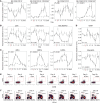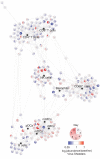Landscape of coordinated immune responses to H1N1 challenge in humans
- PMID: 33044226
- PMCID: PMC7598057
- DOI: 10.1172/JCI137265
Landscape of coordinated immune responses to H1N1 challenge in humans
Abstract
Influenza is a significant cause of morbidity and mortality worldwide. Here we show changes in the abundance and activation states of more than 50 immune cell subsets in 35 individuals over 11 time points during human A/California/2009 (H1N1) virus challenge monitored using mass cytometry along with other clinical assessments. Peak change in monocyte, B cell, and T cell subset frequencies coincided with peak virus shedding, followed by marked activation of T and NK cells. Results led to the identification of CD38 as a critical regulator of plasmacytoid dendritic cell function in response to influenza virus. Machine learning using study-derived clinical parameters and single-cell data effectively classified and predicted susceptibility to infection. The coordinated immune cell dynamics defined in this study provide a framework for identifying novel correlates of protection in the evaluation of future influenza therapeutics.
Keywords: Adaptive immunity; Immunology; Infectious disease; Influenza; Innate immunity.
Conflict of interest statement
Figures









Similar articles
-
Severe pandemic H1N1 2009 infection is associated with transient NK and T deficiency and aberrant CD8 responses.PLoS One. 2012;7(2):e31535. doi: 10.1371/journal.pone.0031535. Epub 2012 Feb 20. PLoS One. 2012. PMID: 22363665 Free PMC article.
-
Distinct T and NK cell populations may serve as immune correlates of protection against symptomatic pandemic influenza A(H1N1) virus infection during pregnancy.PLoS One. 2017 Nov 16;12(11):e0188055. doi: 10.1371/journal.pone.0188055. eCollection 2017. PLoS One. 2017. PMID: 29145441 Free PMC article.
-
Elevated frequency of gamma interferon-producing NK cells in healthy adults vaccinated against influenza virus.Clin Vaccine Immunol. 2008 Jan;15(1):120-30. doi: 10.1128/CVI.00357-07. Epub 2007 Nov 14. Clin Vaccine Immunol. 2008. PMID: 18003818 Free PMC article.
-
[Inhibition of NK cytotoxic effect mediated by influenza A virus H1N1 and the insight into a new concept of therapeutic strategy].Bing Du Xue Bao. 2011 Jan;27(1):81-5. Bing Du Xue Bao. 2011. PMID: 21462512 Review. Chinese. No abstract available.
-
A call to cellular & humoral arms: enlisting cognate T cell help to develop broad-spectrum vaccines against influenza A.Hum Vaccin. 2008 Mar-Apr;4(2):148-57. doi: 10.4161/hv.4.2.5169. Epub 2007 Oct 14. Hum Vaccin. 2008. PMID: 18382131 Review.
Cited by
-
Time-Dependent Variation in Immunoparalysis Biomarkers Among Patients with Sepsis and Critical Illness.medRxiv [Preprint]. 2024 Jul 11:2024.07.11.24310285. doi: 10.1101/2024.07.11.24310285. medRxiv. 2024. PMID: 39040186 Free PMC article. Preprint.
-
Multi-omics analysis of mucosal and systemic immunity to SARS-CoV-2 after birth.Cell. 2023 Oct 12;186(21):4632-4651.e23. doi: 10.1016/j.cell.2023.08.044. Epub 2023 Sep 29. Cell. 2023. PMID: 37776858 Free PMC article.
-
Cyclone: an accessible pipeline to analyze, evaluate, and optimize multiparametric cytometry data.Front Immunol. 2023 Sep 4;14:1167241. doi: 10.3389/fimmu.2023.1167241. eCollection 2023. Front Immunol. 2023. PMID: 37731497 Free PMC article.
-
A systematic analysis of the human immune response to Plasmodium vivax.J Clin Invest. 2023 Oct 16;133(20):e152463. doi: 10.1172/JCI152463. J Clin Invest. 2023. PMID: 37616070 Free PMC article.
-
Qingfei Jiedu Granules fight influenza by regulating inflammation, immunity, metabolism, and gut microbiota.J Tradit Complement Med. 2022 Sep 27;13(2):170-182. doi: 10.1016/j.jtcme.2022.09.001. eCollection 2023 Mar. J Tradit Complement Med. 2022. PMID: 36970461 Free PMC article.
References
-
- WHO. Influenza (Seasonal) 2020. https://www.who.int/en/news-room/fact-sheets/detail/influenza-(seasonal) Updated November 5, 2018. Accessed August 27, 2020.
-
- WHO. Pandemic Influenza Risk Management Guidance. https://www.who.int/influenza/preparedness/pandemic/PIRM_update_052017.pdf Updated May 2017. Accessed August 27, 2020.
-
- Fiore AE, et al. Antiviral agents for the treatment and chemoprophylaxis of influenza — recommendations of the Advisory Committee on Immunization Practices (ACIP) MMWR Recomm Rep. 2011;60(1):1–24. - PubMed
Publication types
MeSH terms
Grants and funding
- R35 GM137936/GM/NIGMS NIH HHS/United States
- UG3 DK114937/DK/NIDDK NIH HHS/United States
- R01 AI108686/AI/NIAID NIH HHS/United States
- U19 AI100627/AI/NIAID NIH HHS/United States
- R01 HL120724/HL/NHLBI NIH HHS/United States
- U01 AI101984/AI/NIAID NIH HHS/United States
- U54 HG010426/HG/NHGRI NIH HHS/United States
- F99 CA212231/CA/NCI NIH HHS/United States
- HHSN272201400005C/AI/NIAID NIH HHS/United States
- R33 CA183692/CA/NCI NIH HHS/United States
- U19 AI135976/AI/NIAID NIH HHS/United States
- R01 GM109836/GM/NIGMS NIH HHS/United States
- R33 CA183654/CA/NCI NIH HHS/United States
- U19 AI057229/AI/NIAID NIH HHS/United States
- U2C CA233238/CA/NCI NIH HHS/United States
- 27145/CRUK_/Cancer Research UK/United Kingdom
- C27165/A29073/CRUK_/Cancer Research UK/United Kingdom
- U01 AI140498/AI/NIAID NIH HHS/United States
- U54 CA209971/CA/NCI NIH HHS/United States
- K23 GM111657/GM/NIGMS NIH HHS/United States
- F32 CA233203/CA/NCI NIH HHS/United States
- P01 HL108797/HL/NHLBI NIH HHS/United States
- R35 GM138353/GM/NIGMS NIH HHS/United States
- R01 AI113047/AI/NIAID NIH HHS/United States
- U2C CA233195/CA/NCI NIH HHS/United States
- R01 CA196657/CA/NCI NIH HHS/United States
- R01 HL128173/HL/NHLBI NIH HHS/United States
- UH2 AR067676/AR/NIAMS NIH HHS/United States
- P01 AI131374/AI/NIAID NIH HHS/United States
- DP2 AR069953/AR/NIAMS NIH HHS/United States
LinkOut - more resources
Full Text Sources
Medical
Research Materials

